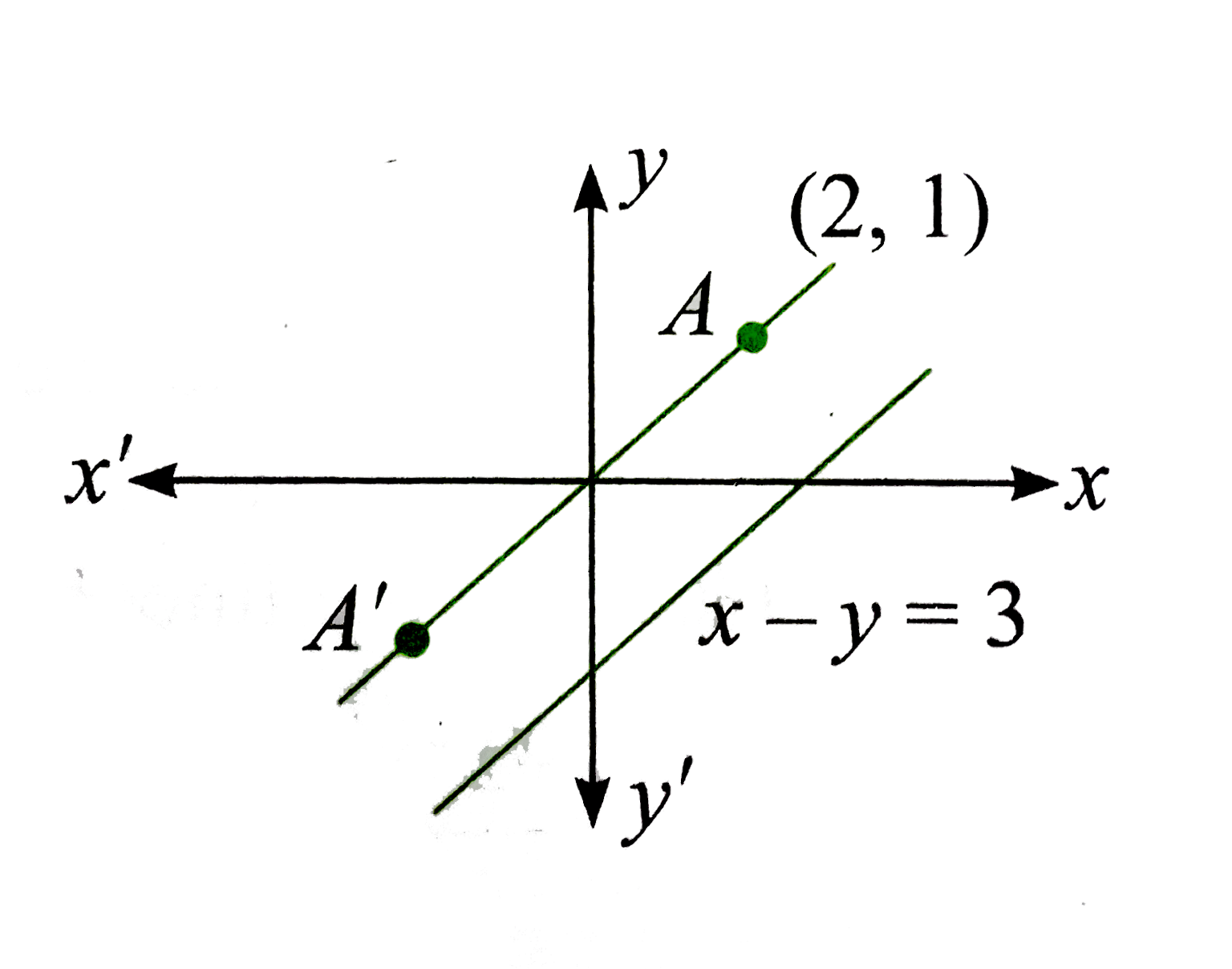The point (2,1) , translated parallel to the line x−y=3 by the distance of 4 units. If this new position A' is in the third quadrant, then the coordinates of A' are-Solution in Bengali
(2+2√2,1+2√2)
(−2+√2,−1−2√2)
(2−2√2,1−2√2)
none of these
The correct Answer is:C

Since the poinnt A(2,1) is translated parallel to x-y=3, A'A has the same slope as that of x-y=3. Therefore, A'A passes through (2,1) and has slope 1. Here, tanθ=1or cosθ=1√2,sinθ=1√2.
Thus, the equation of AA' is
x−2cos(π/4)=y−1sin(π/4)
Since AA' =4, the coordinates of A' are given by
x−2cos(π/4)=y−1sin(π/4)=−4
or x=2−4cosπ4,y=1−4sinπ4
or x=2−2√2,y=1−2√2
Hence, the coordinates of A' are (2−2√2,1−2√2).
Topper's Solved these Questions
- STRAIGHT LINESBOOK - CENGAGE PUBLICATIONCHAPTER - STRAIGHT LINESEXERCISE - EXERCISE (MULTIPLE CORRECT ANSWERS TYPE)
30 Videos
- STRAIGHT LINESBOOK - CENGAGE PUBLICATIONCHAPTER - STRAIGHT LINESEXERCISE - EXERCISE (LINKED COMPREHENSION TYPE)
27 Videos
- STRAIGHT LINESBOOK - CENGAGE PUBLICATIONCHAPTER - STRAIGHT LINESEXERCISE - CONCEPT APPLICATION EXERCISE 2.6
5 Videos
- STRAIGHT LINEBOOK - CENGAGE PUBLICATIONCHAPTER - STRAIGHT LINEEXERCISE - Multiple Correct Answers Type
8 Videos
- THEORY OF EQUATIONSBOOK - CENGAGE PUBLICATIONCHAPTER - THEORY OF EQUATIONSEXERCISE - JEE ADVANCED (Numerical Value Type )
1 Videos
Similar Questions
If P is a point (x,y) on the line y=−3x such that P and the point (3, 4) are on the opposite sides of the line 3x−4y=8, then x>815 (b) x>85 y<−85 (d) y<−815
View SolutionLet l be the line belonging to the family of straight lines (a+2b)x+(a−3b)y+a−8b=0,a,b∈R, which is farthest from the point (2,2), then area enclosed by the line L and the coordinate axes is
View SolutionIf aandb are two arbitrary constants, then prove that the straight line (a−2b)x+(a+3b)y+3a+4b=0 will pass through a fixed point. Find that point.
View SolutionThe point P(α,α+1) will lie inside the triangle whose vertices are A(0,3),B(−2,0) and C(6,1) if
View SolutionThe number of distinct real roots of x4−4x3+12x2+x−1=0is_____.
View SolutionThe point P(1,1) is translated parallal to the line 2x=y in the first quadrant through a unit distance.The coordinates of the new position of P are:
View SolutionThe point (2,1) , translated parallel to the line x−y=3 by the distance of 4 units. If this new position A' is in the third quadrant, then the coordinates of A' are-
View SolutionThe point A(2,1) is translated parallel to the line x−y=3 by a distance of 4 units. If the new position A' is in the third quadrant, then the coordinates of A' are (A) (2+2√2,1+2√2 (B) (−2+√2,−1−2√2) (C) (2−2√2 , 1−2√2) (D) none of these
View SolutionThe point (2,1) is translated parallel to the line L: x-y=4 by 2sqrt(3)units. If the new point Q lies in the third quadrant, then the equation of the line passing through Q and perpendicular to L is
View SolutionThe point (1,-2) is reflected in the x -axis and then translated parallel to the positive diriection of x-axis through a distance of 3 units,find the coordinates of the point in the new position.
View SolutionThe point P(1,1,1) is transiated parallel to 2x=yin the first quadrant through a unith distance. The coordinates of the point in new position are
View SolutionThe point A(2,1) is translated parallel to the line x−y=3 by a distance of 4 units. If the new position A' is in the third quadrant, then the coordinates of A' are (A) (2+2√2,1+2√2 (B) (−2+√2,−1−2√2) (C) (2−2√2 , 1−2√2) (D) none of these
View SolutionThe point (2,1) , translated parallel to the line x−y=3 by the distance of 4 units. If this new position A' is in the third quadrant, then the coordinates of A' are-
View SolutionThe point p(1,1) is translated parallel to 2x=y in the first quadrant through a unit distance. The coordinates of point in new position of p are
View SolutionThe point (4,1) undergoes the following two successive transformations
(i) Reflection about the line y=x
(ii) Translation through a distance of 2 units along the positive x-axis.
The coordinates of the new point are
View Solution
